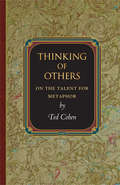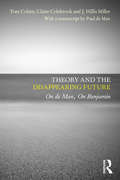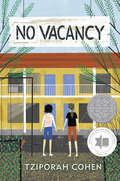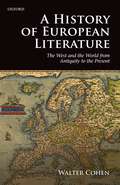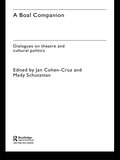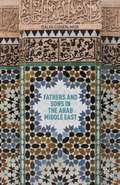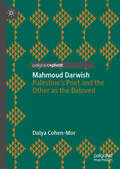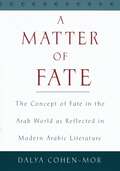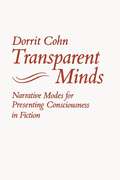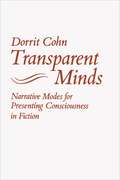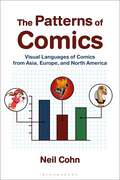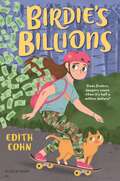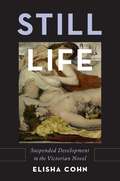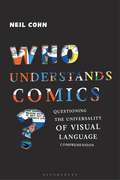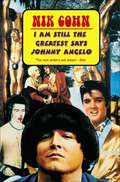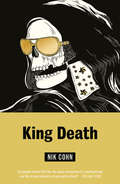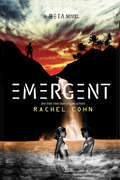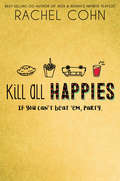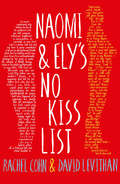- Table View
- List View
Thinking of Others: On the Talent for Metaphor
by Ted CohenIn Thinking of Others, Ted Cohen argues that the ability to imagine oneself as another person is an indispensable human capacity--as essential to moral awareness as it is to literary appreciation--and that this talent for identification is the same as the talent for metaphor. To be able to see oneself as someone else, whether the someone else is a real person or a fictional character, is to exercise the ability to deal with metaphor and other figurative language. The underlying faculty, Cohen argues, is the same--simply the ability to think of one thing as another when it plainly is not. In an engaging style, Cohen explores this idea by examining various occasions for identifying with others, including reading fiction, enjoying sports, making moral arguments, estimating one's future self, and imagining how one appears to others. Using many literary examples, Cohen argues that we can engage with fictional characters just as intensely as we do with real people, and he looks at some of the ways literature itself takes up the question of interpersonal identification and understanding. An original meditation on the necessity of imagination to moral and aesthetic life, Thinking of Others is an important contribution to philosophy and literary theory.
Thinking of Others: On the Talent for Metaphor
by Ted CohenIn Thinking of Others, Ted Cohen argues that the ability to imagine oneself as another person is an indispensable human capacity--as essential to moral awareness as it is to literary appreciation--and that this talent for identification is the same as the talent for metaphor. To be able to see oneself as someone else, whether the someone else is a real person or a fictional character, is to exercise the ability to deal with metaphor and other figurative language. The underlying faculty, Cohen argues, is the same--simply the ability to think of one thing as another when it plainly is not. In an engaging style, Cohen explores this idea by examining various occasions for identifying with others, including reading fiction, enjoying sports, making moral arguments, estimating one's future self, and imagining how one appears to others. Using many literary examples, Cohen argues that we can engage with fictional characters just as intensely as we do with real people, and he looks at some of the ways literature itself takes up the question of interpersonal identification and understanding. An original meditation on the necessity of imagination to moral and aesthetic life, Thinking of Others is an important contribution to philosophy and literary theory.
Theory and the Disappearing Future: On de Man, On Benjamin
by Tom Cohen Claire Colebrook J. Hillis Miller with a de ManPaul de Man is often associated with an era of ‘high theory’, an era it is argued may now be coming to a close. This book, written by three leading contemporary scholars, includes both a transcript and facsimile print of a previously unpublished text by de Man of his handwritten notes for a lecture on Walter Benjamin. Challenging and relevant, this volume presents de Man’s work as a critical resource for dealing with the most important questions of the twenty-first century and argues for the place of theory within it. The humanities are flooded with crises of globalism, capitalism and terrorism, contemporary narratives of financial collapse, viral annihilation, species extinction, environmental disaster and terrorist destruction. Cohen, Colebrook and Miller draw out the implications of these crises and their narratives and, reflecting on this work by de Man, explore the limits of political thinking, of historical retrieval and the ethics of archives and cultural memory.
Theory and the Disappearing Future: On de Man, On Benjamin
by Tom Cohen Claire Colebrook J. Hillis Miller with a de ManPaul de Man is often associated with an era of ‘high theory’, an era it is argued may now be coming to a close. This book, written by three leading contemporary scholars, includes both a transcript and facsimile print of a previously unpublished text by de Man of his handwritten notes for a lecture on Walter Benjamin. Challenging and relevant, this volume presents de Man’s work as a critical resource for dealing with the most important questions of the twenty-first century and argues for the place of theory within it. The humanities are flooded with crises of globalism, capitalism and terrorism, contemporary narratives of financial collapse, viral annihilation, species extinction, environmental disaster and terrorist destruction. Cohen, Colebrook and Miller draw out the implications of these crises and their narratives and, reflecting on this work by de Man, explore the limits of political thinking, of historical retrieval and the ethics of archives and cultural memory.
No Vacancy
by Tziporah CohenWith the help of her Catholic friend, an eleven-year-old Jewish girl creates a provocative local tourist attraction to save her family’s failing motel. Buying and moving into the run-down Jewel Motor Inn in upstate New York wasn’t eleven-year-old Miriam Brockman’s dream, but at least it’s an adventure. Miriam befriends Kate, whose grandmother owns the diner next door, and finds comfort in the company of Maria, the motel’s housekeeper, and her Uncle Mordy, who comes to help out for the summer. She spends her free time helping Kate’s grandmother make her famous grape pies and begins to face her fears by taking swimming lessons in the motel’s pool. But when it becomes clear that only a miracle is going to save the Jewel from bankruptcy, Jewish Miriam and Catholic Kate decide to create their own. Otherwise, the No Vacancy sign will come down for good, and Miriam will lose the life she’s worked so hard to build. Correlates to the Common Core State Standards in English Language Arts: CCSS.ELA-LITERACY.RL.4.6 Compare and contrast the point of view from which different stories are narrated, including the difference between first- and third-person narrations. CCSS.ELA-LITERACY.RL.5.3 Compare and contrast two or more characters, settings, or events in a story or drama, drawing on specific details in the text (e.g., how characters interact). CCSS.ELA-LITERACY.RL.5.4 Determine the meaning of words and phrases as they are used in a text, including figurative language such as metaphors and similes. CCSS.ELA-LITERACY.RL.5.6 Describe how a narrator's or speaker's point of view influences how events are described. CCSS.ELA-LITERACY.RL.6.3 Describe how a particular story's or drama's plot unfolds in a series of episodes as well as how the characters respond or change as the plot moves toward a resolution. CCSS.ELA-LITERACY.RL.6.6 Explain how an author develops the point of view of the narrator or speaker in a text.
A History of European Literature: The West and the World from Antiquity to the Present
by Walter CohenWalter Cohen argues that the history of European literature and each of its standard periods can be illuminated by comparative consideration of the different literary languages within Europe and by the ties of European literature to world literature. World literature is marked by recurrent, systematic features, outcomes of the way that language and literature are at once the products of major change and its agents. Cohen tracks these features from ancient times to the present, distinguishing five main overlapping stages. Within that framework, he shows that European literatures ongoing internal and external relationships are most visible at the level of form rather than of thematic statement or mimetic representation. European literature emerges from world literature before the birth of Europe — during antiquity, whose Classical languages are the heirs to the complex heritage of Afro-Eurasia. This legacy is later transmitted by Latin to the various vernaculars. The uniqueness of the process lies in the gradual displacement of the learned language by the vernacular, long dominated by Romance literatures. That development subsequently informs the second crucial differentiating dimension of European literature: the multicontinental expansion of its languages and characteristic genres, especially the novel, beginning in the Renaissance. This expansion ultimately results in the reintegration of European literature into world literature and thus in the creation of todays global literary system. The distinctiveness of European literature is to be found in these interrelated trajectories.
A Boal Companion: Dialogues on Theatre and Cultural Politics
by Jan Cohen-Cruz Mady SchutzmanThis carefully constructed and thorough collection of theoretical engagements with Augusto Boal’s work is the first to look ’beyond Boal’ and critically assesses the Theatre of the Opressed (TO) movement in context. A Boal Companion looks at the cultural practices which inform TO and explore them within a larger frame of cultural politics and performance theory. The contributors put TO into dialogue with complexity theory – Merleau-Ponty, Emmanuel Levinas, race theory, feminist performance art, Deleuze and Guattari, and liberation psychology – to name just a few, and in doing so, the kinship between Boal’s project and multiple fields of social psychology, ethics, biology, comedy, trauma studies and political science is made visible. The ideas generated throughout A Boal Companion will: expand readers' understanding of TO as a complex, interdisciplinary, multivocal body of philosophical discourses provide a variety of lenses through which to practice and critique TO make explicit the relationship between TO and other bodies of work. This collection is ideal for TO practitioners and scholars who want to expand their knowledge, but it also provides unfamiliar readers and new students to the discipline with an excellent study resource.
A Boal Companion: Dialogues on Theatre and Cultural Politics
by Jan Cohen-Cruz Mady SchutzmanThis carefully constructed and thorough collection of theoretical engagements with Augusto Boal’s work is the first to look ’beyond Boal’ and critically assesses the Theatre of the Opressed (TO) movement in context. A Boal Companion looks at the cultural practices which inform TO and explore them within a larger frame of cultural politics and performance theory. The contributors put TO into dialogue with complexity theory – Merleau-Ponty, Emmanuel Levinas, race theory, feminist performance art, Deleuze and Guattari, and liberation psychology – to name just a few, and in doing so, the kinship between Boal’s project and multiple fields of social psychology, ethics, biology, comedy, trauma studies and political science is made visible. The ideas generated throughout A Boal Companion will: expand readers' understanding of TO as a complex, interdisciplinary, multivocal body of philosophical discourses provide a variety of lenses through which to practice and critique TO make explicit the relationship between TO and other bodies of work. This collection is ideal for TO practitioners and scholars who want to expand their knowledge, but it also provides unfamiliar readers and new students to the discipline with an excellent study resource.
Fathers and Sons in the Arab Middle East
by D. Cohen-MorDrawing on insights from psychology, sociology, anthropology, religion, history, and literature, this book examines early and contemporary writings of male authors from across the Arab world to explore the traditional and evolving nature of father-son relationships in Arab families.
Mahmoud Darwish: Palestine’s Poet and the Other as the Beloved
by Dalya Cohen-MorMahmoud Darwish: Palestine’s Poet and the Other as the Beloved focuses on Palestinian national poet Mahmoud Darwish (1941–2008), whose poetry has helped to shape Palestinian identity and foster Palestinian culture through many decades of the Israeli-Palestinian conflict. Dalya Cohen-Mor explores the poet’s romantic relationship with “Rita,” an Israeli Jewish woman whom he had met in Haifa in his early twenties and to whom he had dedicated a series of love poems and prose passages, among them the iconic poem “Rita and the Gun.” Interwoven with biographical details and diverse documentary materials, this exploration reveals a fascinating facet in the poet’s personality, his self-definition, and his attitude toward the Israeli other. Comprising a close reading of Darwish’s love poems, coupled with many examples of novels and short stories from both Arabic and Hebrew fiction that deal with Arab-Jewish love stories, this book delves into the complexity of Arab-Jewish relations and shows how romance can blossom across ethno-religious lines and how politics all too often destroys it.
A Matter of Fate: The Concept of Fate in the Arab World as Reflected in Modern Arabic Literature
by Dalya Cohen-MorDalya Cohen-Mor examines the evolution of the concept of fate in the Arab world through readings of religious texts, poetry, fiction, and folklore. She contends that belief in fate has retained its vitality and continues to play a pivotal role in the Arabs' outlook on life and their social psychology. Interwoven with the chapters are 16 modern short stories that further illuminate this fascinating topic.
Transparent Minds: Narrative Modes for Presenting Consciousness in Fiction
by Dorrit Claire CohnThis book investigates the entire spectrum of techniques for portraying the mental lives of fictional characters in both the stream-of-consciousness novel and other fiction. Each chapter deals with one main technique, illustrated from a wide range of nineteenth- and twentieth-century fiction by writers including Stendhal, Dostoevsky, James, Mann, Kafka, Joyce, Proust, Woolf, and Sarraute.
Transparent Minds: Narrative Modes for Presenting Consciousness in Fiction
by Dorrit Claire CohnThis book investigates the entire spectrum of techniques for portraying the mental lives of fictional characters in both the stream-of-consciousness novel and other fiction. Each chapter deals with one main technique, illustrated from a wide range of nineteenth- and twentieth-century fiction by writers including Stendhal, Dostoevsky, James, Mann, Kafka, Joyce, Proust, Woolf, and Sarraute.
The Patterns of Comics: Visual Languages of Comics from Asia, Europe, and North America
by Dr Neil CohnComics are a global phenomenon, and yet it's easy to distinguish the visual styles of comics from Asia, Europe, or the United States. But, do the structures of these visual narratives differ in more subtle ways? Might these comics actually be drawn in different visual languages that vary in their structures across cultures? To address these questions, The Patterns of Comics seeks evidence through a sustained analysis of an annotated corpus of over 36,000 panels from more than 350 comics from Asia, Europe, and the United States. This data-driven approach reveals the cross-cultural variation in symbology, layout, and storytelling between various visual languages, and shows how comics have changed across 80 years. It compares, for example, the subtypes within American comics and Japanese manga, and analyzes the formal properties of Bill Watterson's Calvin and Hobbes across its entire 10-year run. Throughout, it not only uncovers the patterns in and across the panels of comics, but shows how these regularities in the visual languages of comics connect to the organizing principles of all languages.
The Patterns of Comics: Visual Languages of Comics from Asia, Europe, and North America
by Dr Neil CohnComics are a global phenomenon, and yet it's easy to distinguish the visual styles of comics from Asia, Europe, or the United States. But, do the structures of these visual narratives differ in more subtle ways? Might these comics actually be drawn in different visual languages that vary in their structures across cultures? To address these questions, The Patterns of Comics seeks evidence through a sustained analysis of an annotated corpus of over 36,000 panels from more than 350 comics from Asia, Europe, and the United States. This data-driven approach reveals the cross-cultural variation in symbology, layout, and storytelling between various visual languages, and shows how comics have changed across 80 years. It compares, for example, the subtypes within American comics and Japanese manga, and analyzes the formal properties of Bill Watterson's Calvin and Hobbes across its entire 10-year run. Throughout, it not only uncovers the patterns in and across the panels of comics, but shows how these regularities in the visual languages of comics connect to the organizing principles of all languages.
Birdie's Billions
by Edith CohnA savvy young girl finds half a million dollars and wonders if she can keep it in this charming middle grade mystery that asks big questions about right, wrong, and what you'd do for family.For as long as eleven-year-old Birdie can remember, it's always been just her and her mom, which means there's not a lot of extra money to spend on things like new clothes and batons from the fancy gymnastics store. Still, they always find a way to make ends meet. Then Birdie makes one silly mistake that has a big consequence: Mom loses her job. Now things are more dire than ever, and Birdie knows it's up to her to fix it. When Birdie discovers a huge stash of cash in an abandoned house, she just knows it must be the answer to their problems. But the people who left that money behind aren't willing to give it up so easily. Does “finders, keepers” count when it's half a million dollars?In this heartfelt small-town story from beloved author Edith Cohn, Birdie learns how to balance what's right for her family-and herself-with what's the right thing to do.
Still Life: Suspended Development in the Victorian Novel
by Elisha CohnStill Life: Suspended Development in the Victorian Novel rethinks the nineteenth-century aesthetics of agency through the Victorian novel's fascination with states of reverie, trance, and sleep. These states challenge contemporary scientific and philosophical accounts of the perfectibility of the self, which privileged reflective self-awareness. In dialogue with the field of literature and science studies and affect studies, this book shows how Victorian writers used narrative form to respond to the analytical practices and knowledge production of those other disciplines. Drawing upon canonical texts--by Charlotte Brontë, George Eliot, George Meredith, and Thomas Hardy--Still Life contends that depictions of non-purposive perceptual experience suspend the processes of self-cultivation (Bildung) central to Victorian aesthetics, science, psychology, and political theory, as well as most critical accounts of the novel form. Departing from the values of individual cultivation and moral revelation associated with the genre, these writers offer an affective framework for understanding the subtly non-instrumental powers of narrative. Victorian novels ostensibly working within the parameters of the Bildungsroman are suspended by moments of "still life": a decentered lyricism associated with states of diminished consciousness. They use this style to narrate what should be unnarratable: experiences not dependent on reflective consciousness, which express a distinctive ambivalence toward dominant developmental frameworks of individual self-culture.
Still Life: Suspended Development in the Victorian Novel
by Elisha CohnStill Life: Suspended Development in the Victorian Novel rethinks the nineteenth-century aesthetics of agency through the Victorian novel's fascination with states of reverie, trance, and sleep. These states challenge contemporary scientific and philosophical accounts of the perfectibility of the self, which privileged reflective self-awareness. In dialogue with the field of literature and science studies and affect studies, this book shows how Victorian writers used narrative form to respond to the analytical practices and knowledge production of those other disciplines. Drawing upon canonical texts--by Charlotte Brontë, George Eliot, George Meredith, and Thomas Hardy--Still Life contends that depictions of non-purposive perceptual experience suspend the processes of self-cultivation (Bildung) central to Victorian aesthetics, science, psychology, and political theory, as well as most critical accounts of the novel form. Departing from the values of individual cultivation and moral revelation associated with the genre, these writers offer an affective framework for understanding the subtly non-instrumental powers of narrative. Victorian novels ostensibly working within the parameters of the Bildungsroman are suspended by moments of "still life": a decentered lyricism associated with states of diminished consciousness. They use this style to narrate what should be unnarratable: experiences not dependent on reflective consciousness, which express a distinctive ambivalence toward dominant developmental frameworks of individual self-culture.
Who Understands Comics?: Questioning the Universality of Visual Language Comprehension
by Neil CohnDrawings and sequential images are so pervasive in contemporary society that we may take their understanding for granted. But how transparent are they really, and how universally are they understood? Combining recent advances from linguistics, cognitive science, and clinical psychology, this book argues that visual narratives involve greater complexity and require a lot more decoding than widely thought. Although increasingly used beyond the sphere of entertainment as materials in humanitarian, educational, and experimental contexts, Neil Cohn demonstrates that their universal comprehension cannot be assumed. Instead, understanding a visual language requires a fluency that is contingent on exposure and practice with a graphic system. Bringing together a rich but scattered literature on how people comprehend, and learn to comprehend, a sequence of images, this book coalesces research from a diverse range of fields into a broader interdisciplinary view of visual narrative to ask: Who Understands Comics?
Who Understands Comics?: Questioning the Universality of Visual Language Comprehension
by Neil CohnDrawings and sequential images are so pervasive in contemporary society that we may take their understanding for granted. But how transparent are they really, and how universally are they understood? Combining recent advances from linguistics, cognitive science, and clinical psychology, this book argues that visual narratives involve greater complexity and require a lot more decoding than widely thought. Although increasingly used beyond the sphere of entertainment as materials in humanitarian, educational, and experimental contexts, Neil Cohn demonstrates that their universal comprehension cannot be assumed. Instead, understanding a visual language requires a fluency that is contingent on exposure and practice with a graphic system. Bringing together a rich but scattered literature on how people comprehend, and learn to comprehend, a sequence of images, this book coalesces research from a diverse range of fields into a broader interdisciplinary view of visual narrative to ask: Who Understands Comics?
I Am Still The Greatest Says Johnny Angelo (No Exit Ace Doubles Ser.)
by Nik CohnI Am Still The Greatest Says Johnny Angelo is Nik Cohn's hymn to rock as myth, in all its crazed, absurd and glorious excess. Partly based on the legendary rocker, P J Proby, Johnny Angelo is the pop star to end all pop stars - narcissistic, mock-heroic and massively destructive. The novel follows his progress from warped infancy to final messianic explosion. A top read, which David Bowie once claimed inspired Ziggy Stardust. Cohn writes in such a rich, strange prose style that its responses linger long after the book's initial impact. His opulent, staccato sentences add weight to the edginess and near hysteria of Johnny Angelo, the novel's central character. And in Angelo, Rock singer and shaman, we have a genuine archetype. - Robert HollandAngelo is the rock writer's wet dream, a mythical, heroic saga which blends pre-Army Elvis with Iggy Pop, Little Richard, Vince Taylor, Screamin' Jay Hawkins and P J Proby - Marc Issue - Blitz
King Death: A No Exit Ace Double (No Exit Ace Doubles Ser.)
by Nik CohnEddie is a strange man with an extraordinary talent that makes him the 'performer' he is. Eddie administers Death. His subjects, he explains, are not afraid, but are thrilled and transported. To Eddie, Death is completion, and he finds fulfilment, satisfaction, and pride in each job he carries out.When Seaton Carew, America's most successful TV entrepreneur, chances to witness Eddie in action, Eddie's career is altered. Overcoming many obstacles, he and Seaton literally ride to glory on the Deliverance Special, a train carrying King Death and his huge entourage all over America. But then a disturbing change comes over Eddie and threatens to topple him from his grisly throne...Part nightmare, part modern fairytale, Nik Cohn has written a bizarre fable for our time. In a cool and highly original style Cohn captures its sickness and horror yet stays true to its grandeur and allure.
Emergent (A Beta Novel)
by Rachel CohnA clone revolution is brewing.Zhara, the First. Elysia, her clone. On the surface, they are identical. But looks can be deceiving. When Zhara plays, she plays to win. She thought she had escaped the horrors of Doctor Lusardi's cloning compound. But the nightmare is just beginning. Elysia has taken everything from Zhara--a softer, prettier version of herself and an inescapable reminder of all she's failed at in her life. Now the man Zhara loves has replaced her with Elysia. Zhara will get her clone out of the way, no matter the cost. Elysia has finally learned the truth: she has a soul. Her First is alive. She knows it hurts Zhara to see her with Alexander, but she can't give him up. The genetically-perfected Aquine has chosen as her as his life mate, and their days together are limited. Elysia can't remain in the Rave Caves off the shores of Denesme forever. Revolution is brewing on the island paradise. Hundreds of soulless clones remain imprisoned like Elysia once was, slaves to the whims of their owners--wealthy human inhabitants of the island. As a group of clones and humans, led by Alexander, plot an insurrection that will turn Denesme's world upside down, Elysia knows her place is fighting by his side. Terrible sacrifices must be made to defeat Denesme's twisted regime. But even the greatest losses cannot prepare Elysia for the ticking time bomb built into her own programming...
Kill All Happies
by Rachel CohnLast Call at Happies! Tonight, 8 P.M. Senior Class Only! Please with the Shhhh?. This is it. Graduation. And Vic Navarro is throwing the most epic party Rancho Soldado has ever seen. She's going to pull off the most memorable good-bye ever for her best friends, give Happies-the kitschy restaurant that is her desert town's claim to fame-a proper send-off into bankruptcy, and oh yes, hook up with her delicious crush, Jake Zavala-Kim. She only needs to keep the whole thing a secret so that her archnemesis, Miss Ann Thrope, Rancho Soldado's nightmare Town Councilwoman and high school Economics teacher, doesn't get Vic tossed in jail. With the music thumping, alcohol flowing, bodies mashing, and Thrope nowhere to be seen, Vic's party is a raging success. That is, until Happies fans start arriving in droves to say good-bye, and storm the deserted theme park behind the restaurant. Suddenly what was a small graduation bash is more like Coachella on steroids with a side of RASmatazz pie. The night is so not going as planned. And maybe that's the best plan of all.
Naomi and Ely's No Kiss List
by Rachel Cohn David LevithanFrom the dream team David Levithan and Rachel Cohn who brought you Nick and Norah’s Infinite playlist. Naomi and Ely prove that any great friendship can be as confusing, treacherous, inspiring and wonderful as any great romance.
